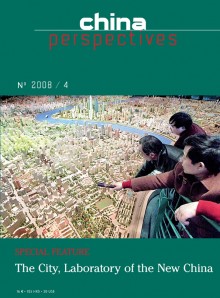
China Perspectives 2008/4
SPECIAL FEATURE
The City, Laboratory of the New China
- Special Feature
- Article
- Book Reviews
City Slums as a Recognition of Migrants’ Rights: A Proposal from Qin Hui
China Analysis
This section, prepared by the Asia Centre (www.centreasia.org), draws mainly on the press in Chinese, aiming to reflect the point of view of the People’s Republic of China on international questions and issues related to Greater China.
Analysis by Hubert Kilian based on:
• Wang Shan, “Ma Ying-jeou and the non-state theory: Taiwan or China’s puppet,” Xin Taiwan Xinwen Zhoukan, n° 651, 11 September 2008.
• Hsueh Hua-yuan, “Ridiculous non-state theory,” Xin Taiwan Xinwen Zhoukan, n° 651, 11 September 2008.
China and Democracy: Sources and Resources
Where Are the Chinese Cities Heading? Three Approaches to the Metropolis in Contemporary China
Metropolisation is essential to approaching the current changes in urban China. We put forward three complementary approaches to understanding the main phenomena that structure the Chinese metropolis today and will mould it tomorrow: hypermodernity, contestation, and regulation.
Shanghai: Urban Planning Styles in Evolution. Emergence of a “Harmonious Urbanisation”?
Since the 1950s, Shanghai has undergone major changes, reflected in the practice of urban planning, which has been influenced by different Western theories. Strategic and collaborative currents as well as the concept of sustainable development have helped reformulate urban planning styles. Does this renewal mean the emergence of an original model of Chinese urban planning, notably with the concept of harmonious urbanisation?
The City as Laboratory and the Urban-Rural Divide: The Revival of Private Property and its Limits in Post-Mao China
This paper focuses on the revival of private property and its limits in urban China. It explores the emergence of urban property markets; urban property-holding in relation to the complexity of urban governance; “minor property rights apartments” that form a de facto real estate market and cross over the urban-rural divide; the “grey areas” of blurring legal and administrative boundaries in modern China; and recent changes to the rural land system and the rural-urban divide. The conclusion flags the theme of the city as laboratory with regard to the blurring legal and governmental urban-rural distinction.
The Dibao Recipients: Mollified Anti-Emblem of Urban Modernization
After the Chinese leadership became cognizant of the negative social externalities of marketization--especially potential threats to its hallowed objectives of social stability and successful state enterprise reform--it initiated a novel welfare approach, the dibao, to handle the people most severely affected by economic restructuring. I review the state’s management of these people and the latter’s experiences. I argue that they are seen subliminally (if not explicitly) by the elite as a menace to officialdom’s modernization ambition. Hence, the dibao is structured so as to keep its targets quiet and out of view, now and into the future.
Making Neighbourhoods: The Government of Social Change in China’s Cities
Based on several years of field research in urban neighbourhoods situated in several Chinese cities this paper investigates the effects of housing reform and the spatial reorganization of China’s cities on the recognition of citizenship rights. It has two main objectives: firstly, to show that there is a direct relationship between the Chinese state’s goal of maintaining social stability and containing social conflicts and the re-zoning of urban residential spaces. And secondly to investigate the role that these spaces and their new governance arrangements play in justifying loyalties towards the state.
Atmospheric Pollution and Urban Development in China
Chinese cities face the challenge of battling air pollution during a time of rapid urbanisation and rising energy demand. Poor air quality is heightening anxiety over the environment. Given pollution’s economic cost, a real policy of monitoring and control has emerged at the national level. Chinese researchers and industry have come up with technological responses to the enormous challenges. While some showcase cities have boosted their pollution-control measures, the situation in smaller ones remains largely catastrophic.
New Public Space in Urban China. Fewer Walls, More Malls in Beijing, Shanghai and Xining
China’s post-reform modernisation and hyper-urbanisation have brought new public spaces to Chinese cities. This article examines the development of a public sphere and five types of new public spaces: newly-open landscapes, squares, commercial spaces, “green” spaces, and transitional spaces. Specific examples are drawn from Beijing, Shanghai, and Xining.
Susan Mann, The Talented Women of the Zhang Family
Adam D. Frank, Taijiquan and the Search for the Little Old Chinese Man: Understanding Identity through Martial Arts
David Shambaugh, China’s Communist Party: Atrophy and Adaptation
Benoît Vermander, Chine brune ou Chine verte? Les dilemmes de l’État-Parti
Sarah Biddulph, Legal Reform and Administrative Detention Powers in China
Ilan Alon and John R. McIntyre (eds), Globalization of Chinese Enterprises
Yan Song & Chengri Ding (eds), Urbanization in China: Critical Issues in an Era of Rapid Growth


